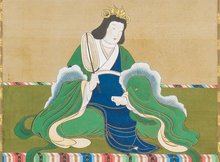
Back الإمبراطورة سويكو Arabic Emperatriz Suiko AST امپراتریس سویکو AZB Emperatris Suiko BCL Імператрыца Суйка Byelorussian Suiko Catalan ئیمپراتۆر سویکۆ CKB Suiko Czech Suiko German Suiko Tennō Spanish
| Empress Suiko 推古天皇 | |||||
|---|---|---|---|---|---|
| Great Queen of Yamato | |||||
 Painting of Suiko by Tosa Mitsuyoshi, 1726 | |||||
| Empress of Japan | |||||
| Reign | 15 January 593 – 15 April 628 (Gregorian calendar) or 8 December 592 – 7 March 628 (Lunar calendar) | ||||
| Predecessor | Sushun | ||||
| Successor | Jomei | ||||
| Regent | Prince Shōtoku (593–621) Soga no Umako Soga no Emishi | ||||
| Empress consort of Japan | |||||
| Tenure | 576 – 585 | ||||
| Born | Nukatabe (額田部) 3 January 554 | ||||
| Died | 15 April 628 (aged 74) | ||||
| Burial | Shinaga no Yamada no misasagi (磯長山田陵) | ||||
| Spouse | Emperor Bidatsu | ||||
| Issue |
| ||||
| |||||
| House | Imperial House of Japan | ||||
| Father | Emperor Kinmei | ||||
| Mother | Soga no Kitashihime | ||||
Empress Suiko (推古天皇, Suiko-tennō) (554 – 15 April 628) was the 33rd monarch of Japan,[1] and the country's first and longest-reigning empress regnant, according to the traditional order of succession.[2]
Suiko reigned from 593 until her death in 628.[3]
- ^ Imperial Household Agency (Kunaichō): She introduced Buddhism in Japan and built many Buddhist temples, but she held the balance between Buddhism and Shintoism. Under her rule, Japan was the superpower in Asia, Silla paid tribute to Japan. She also reorganized the legal system and laws, bringing a peaceful era in the country. She is credited with building Japan's infrastructure, economy and culture. Empress Suiko was noted for her wisdom as a ruler. 推古天皇 (33)
- ^ Ponsonby-Fane, Richard. (1959). The Imperial House of Japan, p. 48.
- ^ Brown, Delmer et al. (1979). Gukanshō, pp. 263–264; Varley, H. Paul. (1980). Jinnō Shōtōki, pp. 126–129; Titsingh, Isaac. (1834). Annales des empereurs du Japon, pp. 39–42., p. 39, at Google Books